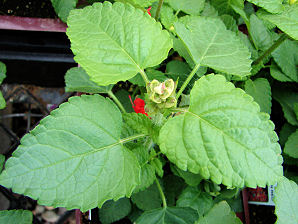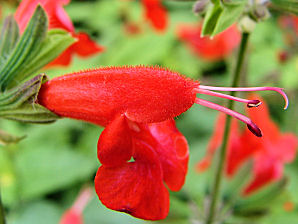Xeriscape Landscaping Plants For The Arizona Desert Environment.
Pictures, Photos, Information, Descriptions,
Images, & Reviews.
Annuals.
Cherry Red Sage, Salvia coccinea.
We Are Proud Of Our SafeSurf Rating!
Click On Any Of The Following Links By Amazon.Com
For Books, & Videos About Wildflowers Of Arizona & The Southwest USA. No Obligation!
 |
| Cherry Red Sage, Salvia coccinea, February 24, 2008. Photo At Glendale, Arizona. |
|---|
 |  |
| Cherry Red Sage Leaves. | Salvia coccinea Flower. |
|---|
 /
/

Cherry Red Sage.
We wish to thank Wikipedia, the free encyclopedia for some of the information on this page. We share images and information with Wikipedia. Cherry Red Sage or Lady In Red Sage is a very attractive annual (Sometimes called perannual), wild flower perfect for the hummingbird garden. Scarlet Sage is a deer resistant wildflower that like most Salvias loves heat. Blood Sage will do well through the hottest weather with or without water. Salvia coccinea prefers sharp-draining soil. Scarlet sage is a sub-shrub perennial in warmer climates and an annual where winter temperatures stay below freezing for more than a few hours at a time. Scarlet sage reaches 2'-4' tall, with 1"-2" triangular leaves on long petioles (leaf stems) opposite each other on a square stem. The showy flowers are bright red, about an inch long, and arranged in loose whorls along the upright stem. Scarlet Sage blooms appear continuously from late winter to first frost. Salvia coccinea can tolerate some shade but does best in full sun, it tolerates drought, but flowering may suffer without supplemental watering. Does best in well drained soil but; will grow in hard, compacted, clay soil, which is a common soil in Phoenix. It is a colorful annual popular with hummingbird, bees, and other birds. Perfect plant for the hummingbird garden.
Quick Notes:
Height: 2 to 4 feet tall. 1 to 2 feet spread.
Flowers: Bright red, about an inch long, and arranged in loose whorls along the upright stem.
Flowering Time: March to November.
Leaves: Simple, ovate, serrate, reticulate, semi-evergreen, green, opposite/subopposite, 1" - 2" triangular leaves on long petioles.
Found: Native to Mexico, but researchers are not sure where in Mexico. The USDA claims it is native of the USA (AL, FL, GA, HI, LA, MS, OH, SC, TX), USA+ (PR, VI).
Hardiness: Said to grow well in Zone 5b. Ogden, Utah.
Soil pH requirements:
Sun Exposure:
Elevation: 0 - 4,900 feet.
Habitat: Sandy desert soils, hot, sunny areas, good drainage, will grow in hard, compacted, clay soil.
Miscellaneous: Flowering Photos Taken February 24, 2008. Glendale, Arizona. Great xeriscape plant.
|



We Are Proud Of Our SafeSurf Rating!
Click On Any Of The Following Links By Amazon.Com
For Books, & Videos About Xerioscape Plants Of Arizona & The Southwest USA. No Obligation!
Back To Arizona Xeriscape Landscaping Main Page.
Back To Xeriscape Annuals Page Two.
Back To DeLange Home Page
© 1966 - Present, Audrey, Eve, & George DeLange
| © 1966 - Present, Audrey, Eve, & George DeLange |

